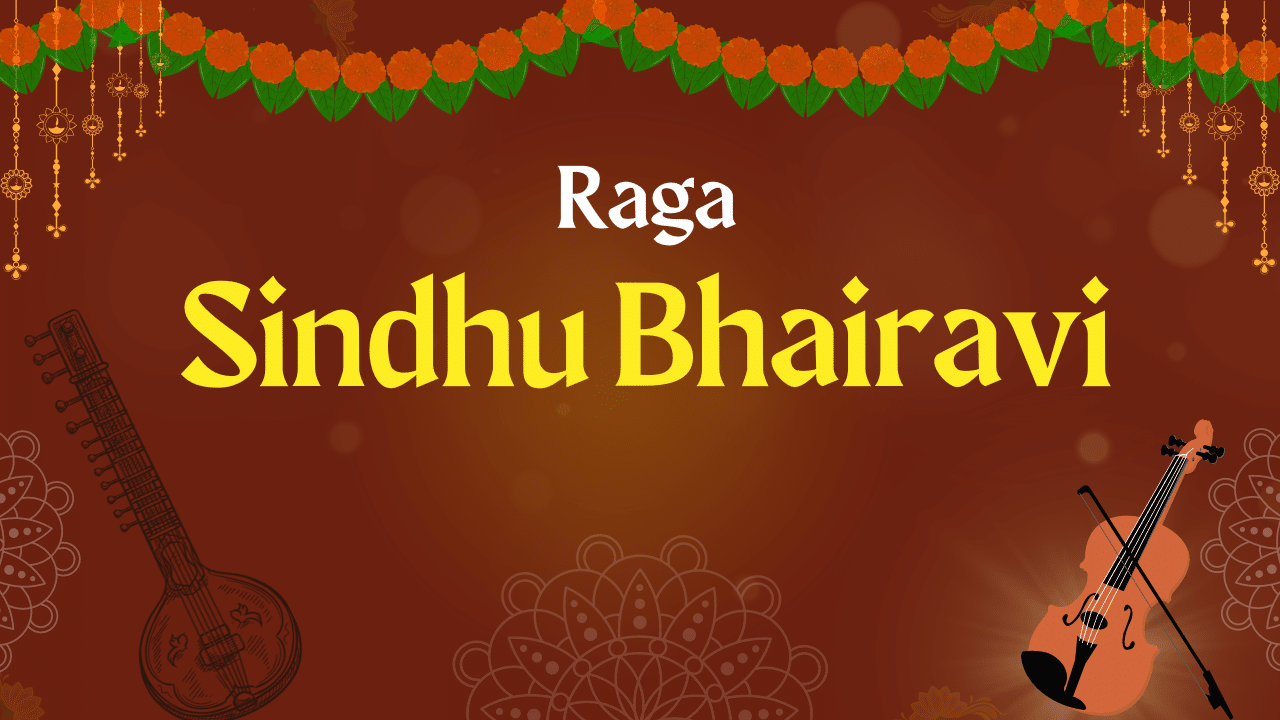Sindhu Bhairavi – a raaga that is otherwise known for the fictional biopic of JKB directed by the veteran director, K. Balachandar. You guessed it right, this scale is extensively covered in the movie as well. One more memory of this raag is the beautiful composition made for the entire nation – Mile Sur Mela Tumhara that started stirring our souls from the Doordarshan days!
The raag oscillates within your soul, shading your emotions with sorrow, devotion and yearning. Let’s delve into this scale in depth together.
Sindhu Bhairavi Notation
The raag is shared by both the styles of Indian classical music including Hindustani and Carnatic.
Aarohanam (Ascending) : S R2 G2 M1 G2 P D1 N2 S’
Avarohanam (Descending) : N2 D1 P M1 G2 R1 S N2 S
Sadjamam, Chatusruti Rishabha, Sadharana Gandharam, Suddha Madhyamam, Panchamam, Suddha Dhaivata , Kaisiki Nishada
In special cases, when the performer decides to experiment, he or she uses Prati Madhyama, Chatusruti Dhaivata, and Kakali Nishadam in this exploratory raag making it a joy to practise while playing with it.
In Hindustani music, this scale belongs to Asaveri thaat while in Carnatic style, this is considered as the child raga of the 8th Melakartha, Hanumathodi. The other speciality of this enchanting raag is it Bhashangaraga attribute that uses all twelve notes.
In arohana, D is noteworthy and in avarohana, the G note makes one feel the true spirit of the scale. They are called vaadi and samvadi respectively.
Healing properties
The scale evokes magic to the listener. The raga is said to cure patients suffering from headaches, back ache and mild chest pain by soothing their nervous system and bringing balance. Bringing tranquillity and peace, this scale plays an important role in music healing therapies.
The Folklore Favorite
As the scale explores all the 12 notes of a given octave, it was very easy for the folklore of the world to adapt their expressions into this raaga. With pathos in its heart, this raga is found in many naatu-pura padal, a famous genre heard by generations in the nooks and corners of Tamil Nadu state.
Famous Compositions – Carnatic Krithis
Many have tried their hands on this exquisite raaga. Saint Purandara Dasa, the Kanada philosopher and musician from the 14th century has composed the famous, Venkatachala Nilayam, Harihara ninnanu, and Kai Meeri Hoda Matige explored by global Carnatic musicians. The saint told the tales of Lord Narasimha, an avatar of Lord Vishu, in his long and magical composition and called it the Narasimhanembo Devanu. A thillana by Lalgudi Jayaraman has made a buzz in the Carnatic world with new aspiring singers composing quirky fusion songs that suit today’s trends.
Some of the notable compositions in this scale are as follows:
- Enu Karanadinda, Sharanu Sheshachala by Vijaya Dasa
- Kalyana Gopalam – Narayana Theertha
- Kantamam – Mayuram Viswanatha Sastri
- Krishnana Kolalina Kare By P T Narasimhachar
- Vishweshwar Darshan, Bhaja Bhaja, Ramachandra Prabhu – Maharaja Swathi Thirunal
- Pahi Pahi Gajanana – Sri Ganapathy Sachchidananda Swamiji
Famous Compositions in Film Music
One of the oldest compositions that was hummed in every Tamil household is from the 1943 movie, Sivakavi.
From then many music directors have taken their take of this easy-going scale from veterans like MSV to today’s D. Imman. Below are some of the notable film songs with notable lines that typically fall into the scale’s order.
Kaatrinile Varum Geetham by M.S Subbulakshmi composed by S. V. Venkatraman in 1945 talking about how the person is waiting to hear the melodious lullaby of Lord Krishna that is engulfed into his magic with a single glance. This is one of the few movies that the late legendary Carnatic musician acted in and is revered across the world.
Vaarayo Thozhi Vaarayo where a bunch of maidens welcome the bride to get hitched in the movie, Pasamalar, depicting the loving relationship of a brother and sister, composed by the evergreen duo, Vishwanathan – Ramamoorthi. How can we forget the ravishing yesteryear actor/ politician, J. Jayalalithaa yearns her love to the late chief minister, M.G. Ramachandran singing Unnai Naan Santhithen telling he is one among a thousand whom she has ever met!
Mahakavi Bharathiar’s Theeratha Vilaiyattu Pillai set in 5/4 time signature from Vedhala Ulagam (1948) sung by the legendary D. K. Pattamal is a song that we can often hear in a Carnatic or semi-carnatic song set in Sindhu Bhairavi.
The epitome of friendship is showcased in this scale through this poised raga in Unakenna Mele Ninrai from Shimla Special with the choreographed piece performed by Kamal Hassan.
Many other favourites like the soulful Shenbagame Shenbagame from Enga Ooru Pattukaran, the epic Valai Osai from Sathya movie starring Kamal and Amala, Oru Naalum Unnai from Superstar Rajnikanth’s Ejamaan, and heart-wrenching Keladi Kanmani from Pudhu Pudhu Arthangal intertwine powerful lyrics to this enchanting scale.
The next era of this raaga was taken over by the oscar winner, A R Rahman in songs like the eloquent Margazhi Thingal Allava (Sangamam), the emotional Enge Enadhu Kavidhai (Kandukonden Kandukonden), the romantic Nenjinile (Uyire), and refreshing Kulirudhu Kulirudhu (Taj Mahal).
Sources say that the lead singer of Shenbagame from Enga Ooru Pattukaran, Asha Bhonsle, broke down into tears while singing this track. That is the true power of this raga.
I cannot forget the chirpy humming of K.S Chitra to the tune of Idhu Dhaana from Saamy with the romantic chemistry shared by the actors, Trisha and Vikram, composed by Harris Jayaraj. Some dance numbers like Naa Soodana Mogini from Paayum Puli scored by D. Imman and Namma Kattula Mazhai Peiyuthu by Yuvan Shankar Raja also make this raaga a versatile one.
Sindhu Bhaiaravi – a scale loved by all
There are many other compositions in different Indian languages adapted by musicians and producers becoming a crowd favourite. From elaborate aalaps, to fun folk songs and easy devotional bhajans, this raga exudes every emotion possible.
Tell us your favourite Sindhu Bhairavi song.
FAQs
1. What is Sindhu Bhairavi?
Sindhu Bhairavi is a Carnatic Raga derived from the 8th Melakartha raga, Hanumathodi. In Hindustani style of music, it falls under the Asaveri category.
2. How to identify Sindhu Bhairavi raga?
There are specific combinations that you can identify like S R2 G R1 S N1 S and P D2 N1 D1 P, that will determine the usage of this raaga.
3. What are the characteristics of Sindhu Bhairavi?
Since this is a Bhashangara raga, all 12 notes are acceptable making this scale interesting but difficult to master at the same time. So you need to have reference points of film songs or Carnatic krithis to understand it completely.
4. What are the Arohana and Avarohana of Sindhu Bhairavi?
The Arohana and Avarohana of Sindhu Bhairavi are as follows:
Arohana: S R2 G1 M1 P D1 N1 Ṡ
Avarohana: Ṡ N1 D1 P M1 G1 R1 S
5. Which songs are composed in Sindhu Bhairavi?
There are many songs that are composed in films, and Carnatic krithis. One of the most favourite in Carnatic is Venkatachala Nilayam composed by Saint Purandara Dasa and in films Naan Oru Sindhu from Sindhu Bhairavi movie. Ironic right?
6. Who are famous composers of Sindhu Bhairavi?
Many composers have explored this raaga including AR Rahman, Illaiyaraja, KV Mahadevan, MS Vishwanathan, D. Imman, and G V Prakash.
7. How to play Sindhu Bhairavi on the violin?
I highly recommend you to go to a tutor for the same. If not, you can start exploring the notes of Arohana and Avarohana in different permutations.
8. What are the famous performances of Sindhu Bhairavi?
The Thillana by many musicians like Ranjini Gayathri, Sathyaprakash’s ensemble by music mojo and violin performance by Mysore Brothers are notable performances you need to watch.































